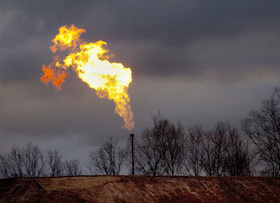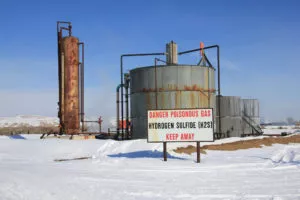For years, residents of oil and gas field communities have reported health problems that either started or got worse after oil and gas development activities began in the area where they live, work, and play. The most widespread symptoms include respiratory problems like asthma and coughing, eye, nose, and throat irritation, headaches, nausea, dizziness, trouble sleeping, and fatigue.
In response, industry and its proponents have often said that these reports of health impacts are just a few isolated “anecdotes.” But communities and individuals living with oil and gas development know that’s not true—and in recent years clear evidence has backed this up.
Today, more than 12 million US residents live within a half-mile of an oil or gas well or facility. Health impacts can result from oil and gas pollution, the creation and storage of waste, and the constant noise and light that exist around operations.
The toxic nature of hundreds of the chemicals and pollutants associated with oil and gas development is scientifically well-established. In addition, the number of research studies on health problems has also grown in recent years.
Demonstrating connections
Even with all this information and clear patterns in symptoms and experiences, it can be difficult to connect activities at specific well sites or facilities with the health of people living nearby. Even though they may have ample evidence, too often residents have to bear a heavy burden of proof regarding the harm they experience.
Two key challenges in demonstrating connections are:
- Most monitoring of air and water quality is done around large urban areas and for public water supplies—which excludes many oil and gas field communities. In addition, state and federal environmental and regulatory agencies generally conduct testing only in response to resident complaints or when problems become so severe that they are investigated.
As a result, residents need more “baseline” data to show that their air and water quality were different before oil and gas activities started—and in turn that operations changed conditions. Fortunately, community groups and researchers work to close this information gap.
- Second, regulators and health agencies have developed “safety” standards through testing of single chemicals and one-time (generally 8-hour) exposures. But people living near gas wells and facilities day in and day out, as well as workers at job sites, are often subjected to multiple toxic substances simultaneously and on a chronic, long-term basis.
This gap makes it possible for industry to assert that their operations are safe as long as concentrations of chemicals are below a certain threshold—regardless of how many chemicals exist in air or water or the changes that residents experience.
In addition, health standards may not exist for many of the pollutants associated with both oil and gas activities. It’s important for oil and gas field residents to share information and experiences so that patterns in health exposures and symptoms can be identified. In turn, the more evidence there is, the harder it will be for industry and officials to deny the reality of health impacts.
For More Information
Fact Sheets
- Oil and Gas Pollution: Contaminants associated with the various stages of oil and gas development
- Think Again: Air pollution from oil and gas facilities
- Pits: Contamination and regulation issues
States
- COLORADO Oil and Gas Health and Toxics Issues
- NEW MEXICO Oil and Gas Health and Toxics Issues
- TEXAS Oil and Gas Health and Toxics Issues
Publications
- Gas Patch Roulette How Shale Gas Development Risks Public Health in Pennsylvania
- Californians at Risk — An Analysis of Health Threats from Oil and Gas Pollution in Two Communities (2015)
- Blackout in the Gas Patch — How Pennsylvania Residents are Left in the Dark on Health and Enforcement (2014)
- Reckless Endangerment While Fracking the Eagle Ford Shale — Government fails, public health suffers and industry profits from the shale oil boom (2013)
- Natural Gas Flowback: the Dark Side of the Boom — How the Texas natural gas boom affects community health and safety (2011)
- Health Survey Results of Current and Former DISH/Clark, Texas Residents (2009)
- Community Survey Reveals Health Impacts in Pavillion, WY Gasfield (2010)
- Colorado Health and Toxics
- Understanding your Water and Air Tests (2012)
Voices
Other
- Find out about the wells and facilities near you with the Oil and Gas Threat Map.
- Sign up and get information on the Shale Gas & Oil Health Registry and Resource Network by the Southwest Pennsylvania Environmental Health Project.
- Read stories of impacted community members struggling with health issues.
- Physicians, Scientists, and Engineers for Healthy Energy database of peer-reviewed studies on the health impacts of unconventional natural gas development.
- Endocrine Disruption Exchange
- Concerned Health Professionals of NY Compendium of Scientific, Medical, and Media Findings Demonstrating Risks and Harms of Fracking
- New Solutions Journal Investigating Links Between Shale Gas Development and Health Impacts through a Community Survey Project in Pennsylvania
- 2010 People’s Oil and Gas Summit – Toxics in Our Communities drew together people from across North America to talk about public health and toxics issues related to oil and gas development.
- NIH Birth Outcomes and Maternal Residential Proximity to Natural Gas Development in Rural Colorado
- NYU School of Law, The State Energy & Environmental Impact Center Climate & Health Showdown in the Courts




